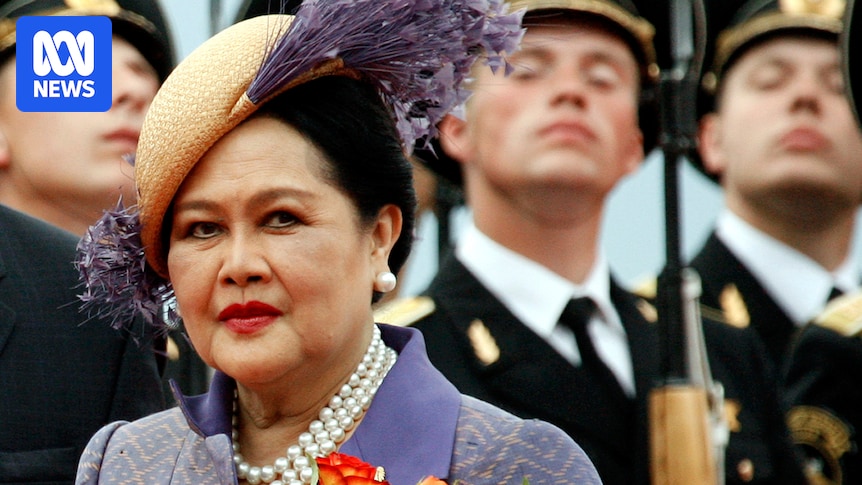Thailand’s Queen Mother Sirikit, who supervised royal projects to help the poor, preserve traditional craft-making and protect the environment, died on Friday at the age of 93.
The Royal Household Bureau said she died in a hospital in Bangkok.
Since October 17 she had been suffering from a blood infection and she had been largely absent from public life in recent years due to declining health.
Her husband, King Bhumibol Adulyadej, died in October 2016.
Queen Sirikit had royal ancestors. (AP)
The queen’s son, King Vajiralongkorn, has instructed the palace to prepare a funeral with the highest honours and ordered a one-year mourning period for the royal family and royal court, local media reported.
The queen will lie in state at the Grand Palace in Bangkok.
King Bhumibol and Queen Sirikit of Thailand
Although overshadowed by her late husband and her son, Sirikit was beloved and influential in her own right.
Her portrait was displayed in homes, offices and public spaces across Thailand and her August 12 birthday was celebrated as Mother’s Day.
Her activities ranged from helping Cambodian refugees to saving some of the country’s once-lush forests from destruction.
Yet as the monarchy’s role in society was increasingly scrutinised during Thailand’s last decades of political turbulence, so too was the queen’s part in it.
Stories circulated of her behind-the-scenes influence during two military takeovers and several rounds of bloody street protests.
When she attended the funeral of a protester killed during a clash with police, many she had taken a side in the political schism.
Queen Mother Sirikit retired from public life in 2016. (Reuters: Kerek Wongsa)
An aristocratic family
Sirikit Kitiyakara was born into a rich, aristocratic family in Bangkok on August 12, 1932, the year absolute monarchy was replaced by a constitutional system.
Both of her parents were related to earlier kings of the current Chakri dynasty.
She attended schools in wartime Bangkok, which were the target of Allied air raids, and after World War II moved with her diplomat father to France, where he served as ambassador.
At 16, she met Bhumibol in Paris, where she was studying music and languages.
King Bhumibol and Sirikit married in 1950 and had four children. (Wikimedia Commons)
Their friendship blossomed after Bhumibol suffered a near-fatal car accident.
Sirikit moved to Switzerland, where he was studying, to help care for him and the king courted her with poetry and composed a waltz titled I Dream of You.
The pair married in 1950 and at a coronation ceremony later the same year both vowed to “reign with righteousness for the benefit and happiness of the Siamese people”.
The couple had four children: reigning King Maha Vajiralongkorn and princesses Ubolratana, Sirindhorn and Chulabhorn.
During their early married life the Thai royals crisscrossed the world as goodwill ambassadors and forged personal ties with world leaders.
Developing rural Thailand
But by the early 1970s, the king and queen were devoting most of their energies to Thailand’s domestic problems, including rural poverty, opium addiction among hill tribes and a communist insurgency.
Every year the couple travelled the countryside while also officiating at more than 500 royal, religious and state ceremonies.
Some in Bangkok gossiped about Sirikit’s involvement in palace intrigues and her lavish lifestyle, but her popularity in the countryside endured.
“Misunderstandings arise between people in rural areas and the rich, so-called civilised people in Bangkok,” she said in an interview with the Associated Press in 1979.
“People in rural Thailand say they are neglected and we try to fill that gap by staying with them in remote areas.”
Royal development projects were set up across Thailand, some of which were initiated and directly supervised by the queen.
To increase the income of poor rural families and preserve dying crafts, the queen in 1976 launched SUPPORT, a foundation that has trained thousands of villagers in silk-weaving, jewellery-making, painting, ceramics and other traditional pastimes.
The late King Bhumibol Adulyadej and Queen Sirikit are revered by much of the Thai public, who often wear yellow to show their support. (Reuters: Chaiwat Subprasom)
Sometimes dubbed the “Green Queen,” she also set up wildlife breeding centres, “open zoos,” and hatcheries to save endangered sea turtles.
Her Forest Loves Water and Little House in the Forest projects sought to demonstrate the economic gains of preserving forest cover and water sources.
While royalty elsewhere had only ceremonial or symbolic roles, Queen Sirikit believed the monarchy was a vital institution in Thailand.
“There are some in the universities who think the monarchy is obsolete. But I think Thailand needs an understanding monarch,” she said in the 1979 interview.
“At the call, ‘The king is coming,’ thousands will gather.
“The mere word king has something magic in it. It is wonderful.”
With AP

